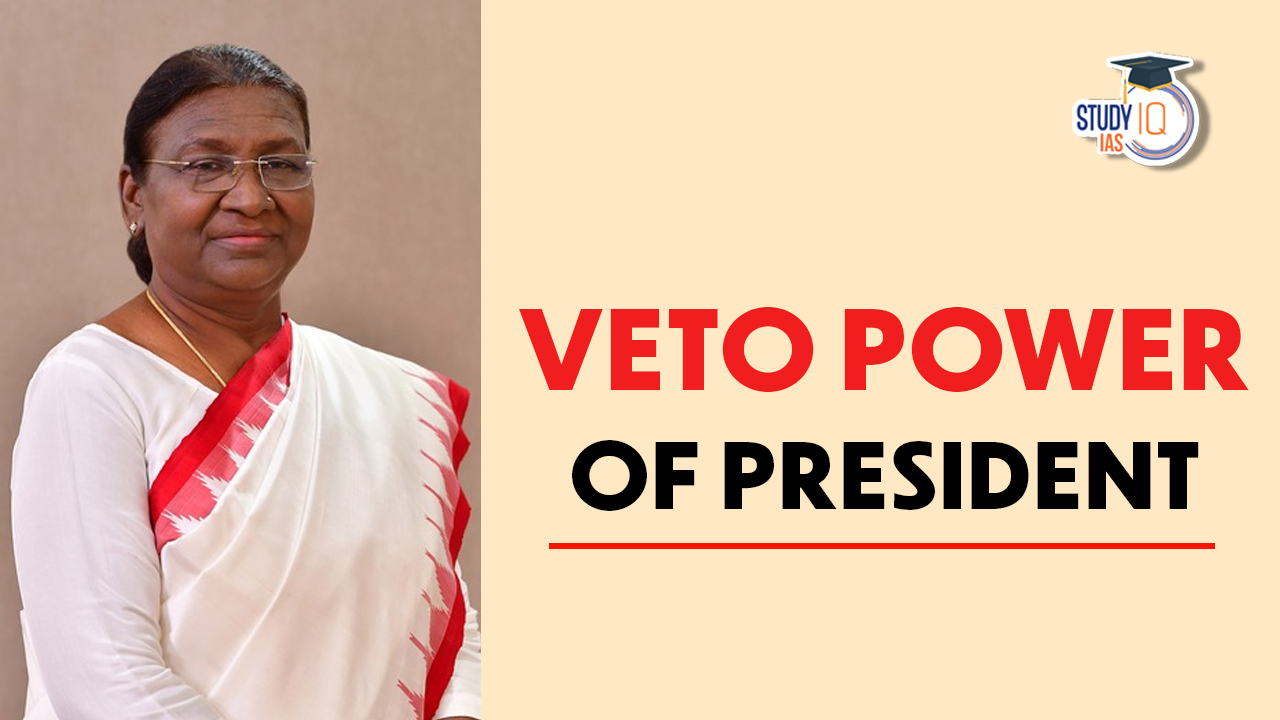Table of Contents
Veto Power of President
The term “veto” comes from Latin and means “to forbid.” A presidential veto is a constitutional tool that allows the President to refuse to approve a bill passed by the legislature. For a bill to become a law, it must be approved by both houses of Parliament and then receive the President’s approval. In the Indian Parliamentary system, the veto is a way for the executive branch to reject decisions made by the legislature.
The Veto Power of President is an important part of Indian Polity which an important subject in UPSC Syllabus. Students can also go for UPSC Mock Test to get more accuracy in their preparations.
Veto Power of President Meaning
The most important power given to the President regarding laws from the legislature is the veto power. The President can completely reject any bill that has been passed by both houses of Parliament and another legislative body. For a bill to become a law, it must be approved by both houses and the President. The term “Veto Power of the President” refers to the President’s ability to reject, cancel, or refuse a bill.
Veto Power of President Types
Article 111 of the Indian Constitution specifies that the President of India has a limited right of veto. The President is granted three different vetoes:
- Absolute Veto Power
- Suspensive Veto Power
- Pocket Veto Power
The various veto powers given to a nation’s president serve different purposes. They are meant to protect constitutional principles, ensure laws are carefully reviewed, maintain a balance of power, and prevent harmful or unconstitutional laws from being passed.
Absolute Veto Power of Indian President
When a bill is passed by Parliament and sent to the President, he has the complete power to accept or reject it. If he uses his absolute veto, the bill does not become law and effectively dies, even though it was approved by the legislature.
The absolute veto is often used when a private member’s bill is approved. If the cabinet changes before the President gives his approval, the new cabinet may not support the previous cabinet’s bills. India has used absolute veto power before; for example, Dr. Rajendra Prasad used it in 1954, and K. Venkatraman used it in 1991.
Suspensive Veto Power of President
The President can use the Suspensive Veto to send a law back to the legislature for more review. However, if Parliament sends the same bill back to him without any changes, he must approve it.
This rule doesn’t apply to state legislatures. The President can still refuse to sign a state law, whether it’s been changed or not. When considering the law, the President only needs a simple majority, not a larger one. The Suspensive Veto does not apply to money bills.
Pocket Veto Power of President
In a pocket veto, the President can choose not to act on a bill from the legislature for an indefinite time without giving a reason or rejecting it. In India, this allows the President to keep the bill “in his pocket” while he assesses the situation.
Unlike in India, the US President must return a bill within 10 days, so they don’t have a pocket veto. This power is unique to the Indian President. Giani Zail Singh used the pocket veto in 1986. However, the President cannot use this power for Constitutional Amendment Bills, as they must take action on them.
Veto Power of President India Article
The President has the authority to approve a law after the parliament has passed it under clause 111, the veto power clause. Regarding the measure, the president has three options. The President has three options: Accept the Bill, Refuse the Bill, and Return the Bill. The President must also accept the law if the legislature sends it again.
Suspensive Veto Power as per Article 111
The President has the authority to send a bill back to parliament for reconsideration if he believes it violates the constitution. If the measure pertains to a constitutional amendment, the President cannot refuse to accept and approve it. According to the definition of the term “pocket veto,” the president has the ability to keep a bill that has been delivered to him in his possession for an indefinite period of time if he chooses not to act on it.
Types of Veto Power for Bill
President can use the veto power for approval in a different bill:
| Type of Bill | Veto Power of President |
| Ordinary Bill | The President has three options. He has three options: 1) accept it, 2) refuse it, and 3) return the bill. |
| Money Bill | The President has the following options: accept it, hold it pending, or refuse to accept it; he cannot send the measure back for reconsideration. |
| Constitutional Amendment Bill | President must accept it |
Presidential Veto Power over State Legislations
When a state legislature passes a bill, it can only become law if the governor of that state approves it. According to Article 200 of the Indian Constitution, the governor has four options:
- Approve the bill.
- Reject the bill.
- Return the bill for more review (unless it’s a money bill).
- Set the bill aside for the President’s consideration.
The governor can reserve a bill for the President if it could harm the High Court or if it involves property laws that need presidential approval under Articles 31A and 31C. Once a bill is reserved for the President, the governor has no further role in it.
When a bill is with the President, he can:
- Approve the bill.
- Reject the bill.
Ask the governor to return the bill for more review (if it’s not a money bill).
Qualified Veto Power of President
The American president has more veto authority than the Indian president, who only has three categories of veto power. This is the difference between the two presidents’ powers. The US President has designated the veto as the fourth of the four veto powers he holds.
Qualified Veto Power of President Meaning
If the President sends a bill back to the legislature for changes, the legislature can then send it back to the President with a special majority to override the veto. Unlike the US President, who must return a bill within 10 days of Congress presenting it, the Indian President does not have any time limits for this.
Veto Powers of President Use
Here are a few instances where the president of India used his constitutional veto power.
Absolute Veto Power of President Use
In 1954, Rajendra Prasad used his veto power to reject the PEPSU appropriation bill, even though the legislature had already approved it. Similarly, R. Venkataraman opposed a member of Parliament’s sales allowance and pension.
Pocket Veto Power of President Use
President Zail Singh used his absolute veto power to stop a bill that was criticized for threatening press freedom and free speech. He also exercised his pocket veto by not acting on the Indian Post Office Amendment Bill, keeping it with him for an extended period.
Suspensive Veto Power of President Use
The President’s Suspensive Veto Power lets him send a bill back to Parliament for more review. If the bill is sent back again, it must be approved. In 1989, K. Venkatraman used this power to return the India Post Office Bill for reconsideration, leading the national front administration to abandon it.
Veto Power of President UPSC
The president has the right to veto any bill that is passed in a hurried or incorrect manner. The sole purpose of the absolute veto is to prevent the passage of any laws that are unconstitutional. The purpose of the suspensive veto is to reexamine a crucial issue or a potential future circumstance that calls for reexamination. The pocket veto gave CEOs the freedom to respond to any political emergency that arose as a result of any legislation. Students can read all the details related to UPSC by visiting the official website of StudyIQ UPSC Online Coaching.


 Places of Worship Act 1991, Key Provisio...
Places of Worship Act 1991, Key Provisio...
 MP moves breach of privilege against Uni...
MP moves breach of privilege against Uni...
 Cut Motions, Meaning, Types and Admissib...
Cut Motions, Meaning, Types and Admissib...




















